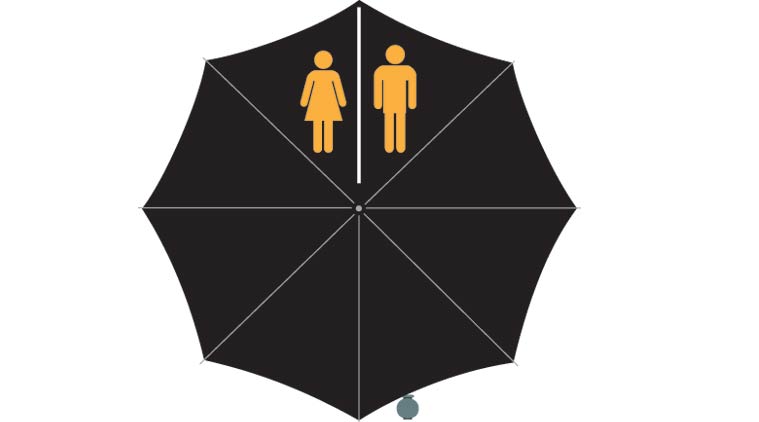- India
- International
Right to a toilet
For the health, dignity and safety of women in slums, a comprehensive policy for the maintenance and construction of public toilets is needed.
 The BMC study revealed that 58 per cent of community toilets in slums have no electricity.
The BMC study revealed that 58 per cent of community toilets in slums have no electricity.
Living in a slum in Bandra West close to the railway station, Vijaya wakes up every morning to anxiety over the trek she and her daughter must take into the open, carrying water cans, to answer nature’s call. They could use the community toilet nearby, but it’s in terrible shape and it’s simply easier to head into the open, despite the daily trauma.
Open defecation poses a serious threat to the health of children in India and is the main reason why India reports the highest diarrhoeal deaths among children under five. Additionally, in women, it is linked to other health problems, such as urinary tract infections, kidney and bladder malfunctions due to prolonged retention periods. According to the latest UNICEF report, open defecation puts at risk the dignity of women in India and they are constrained to relieve themselves only under the cover of dark for reasons of privacy.
This reality is faced by over 20 per cent of Mumbai’s residents — alarming because, according to Census 2011, over nine million people live in the slums of Mumbai. According to a six-month intensive study on slum toilets in Mumbai by Payal Tiwari of the Observer Research Foundation (ORF), defecating in the open is a compulsion, not a choice. “If we had proper toilets in our home or close by, would I allow my daughter to risk her life to go in the open?” questions Vijaya. The fact, endorsed by a recent study by the Brihanmumbai Municipal Corporation (BMC), is that toilets in slums are in a deplorable state. The BMC study revealed that 58 per cent of community toilets in slums have no electricity, 78 per cent have no water or proper sewerage connection. Countless such toilets, many constructed by the Maharashtra Housing and Area Development Authority (MHADA) or the BMC, don’t have doors, latches or proper ventilation.
My own interactions with slum residents led me to discover more reasons why they prefer to defecate in the open. The slum toilets that I entered have been filthy. Apart from the unbearable stench, there are cockroaches, lizards, rats and even maggots around the toilet complexes. In many places, women squat with the doors ajar, for ventilation. Further, the men’s and women’s sections are often not segregated properly, leading to safety issues for women.
One slum resident pointed out to me that it’s easier for her to defecate in the open than to wait in the painfully long queues. There are fewer toilet seats for women than for men. There is also the recurring problem of used sanitary pads strewn around or stuffed down toilets or in the toilet windows, blocking ventilation. Why cannot women who use them dispose of them properly? This is something residents can control.

Children almost always defecate in the open. According to Tiwari, “Children are often shooed away from toilet queues because they take too much time. Also, it is easier for children to squat anywhere.” Open defecation as a practice is inculcated in children when they are young, making the act acceptable to them. This is an outcome of the lack of infrastructure and the lack of motivation to put an end to the practice.
According to the ORF report, at the Jai Santoshi Mata Nagar slum in Sahargaon, Andheri East, there’s only a handful of toilets for the thousands of slum residents. These toilets are in such despicable condition that residents prefer to defecate along both sides of the road, either early in the morning or after dark, using umbrellas to cover themselves.
In the Ambujwadi slum in Malvani, there’s not a single toilet, so residents have no choice but to defecate in the forested area nearby. An area has been designated as the community toilet and men’s and women’s sections identified. But it’s the women who suffer the most, protecting their dignity from Peeping Toms with cameras. The women speak of men with their pants down making lewd gestures at them. In the monsoon, the area becomes slushy, leading to accidents, especially among the elderly women. In one incident, a girl was abducted when she went to defecate. Another time, a woman was saved by her alert mother-in-law before she could be dragged away by men. Women here also have to keep a lookout for wild pigs. Disturbingly, to avoid going to the jungle, some women, especially pregnant women, use a designated sari to defecate in.
There’s a wide gap between demand and supply. Did you know that in Mumbai, currently, there’s only one toilet seat per 1,800 women and that there’s a shortfall of over 65,000 public toilet seats? As I see it, the root of the problem lies in the lack of willingness to address public issues. A comprehensive and uniform policy for the maintenance and construction of public toilets is what we need. Hollow election-time promises will only compound the problems for women.
Prashant Patil, deputy municipal commissioner, says pay-and-use toilets are better because they are maintained better. The reality, however, is that all toilets in slums are overused, under-cleaned and insufficient for the population. Vijaya points out that the public toilet close to her home was constructed by a local politician years ago. The politician gave them locks to keep the toilet complex safe, but the latches were soon broken by those who came from the railway station nearby to use the toilet. Now, the drains are perpetually choked. “In the monsoon, the gutters right outside our homes overflow and the stench is unbearable,” says Vijaya. She brings things into perspective. She points out that politicians only repair or construct toilets when it’s election time. Soon after elections, the people are forgotten.
From the recommendations in the ORF report and my own investigation, I believe sanitation in Mumbai’s slums is a top priority. Building a minimum of 1,00,000 new toilet seats before the end of 2016 is a must. These toilets must be useable, connected to the sewerage system and electrified. I recommended that new legislation be brought in to make the UN-endorsed right to safe water and sanitation a fundamental right of every Indian citizen. I propose the creation of a single, empowered and apex-level Mumbai sanitation and cleanliness authority under the BMC that does away with multiple agencies. I also propose looking into bio-toilets.
This is really the need of the hour and I cannot stress enough the importance of adequate, improved and safe sanitation for the city of Mumbai.
EXPRESS OPINION
Apr 25: Latest News
- 01
- 02
- 03
- 04
- 05










































